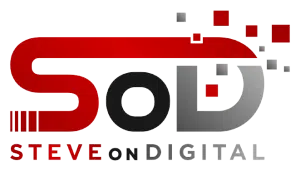How Can SMEs Be Sustainable? | A Complete Guide
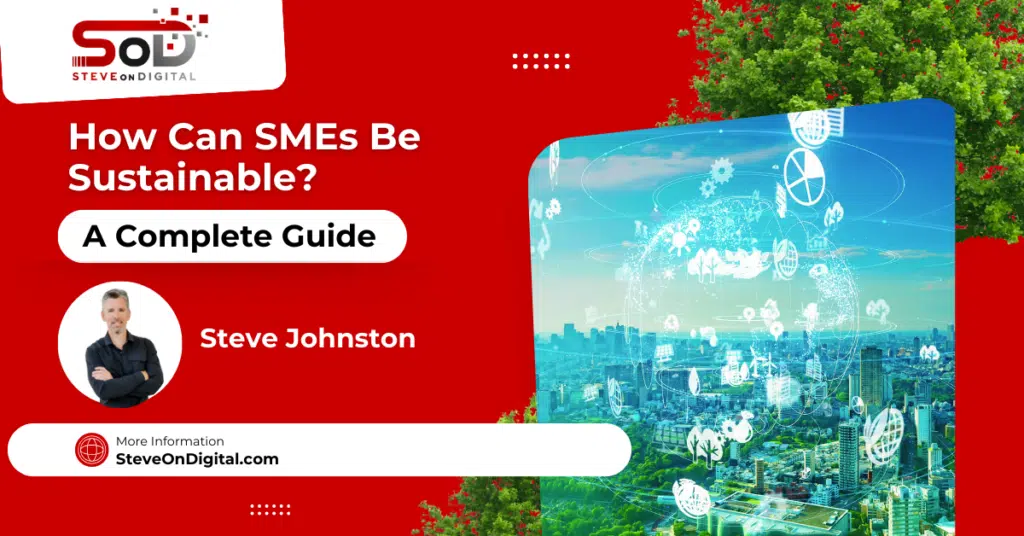
Hello there! I’m Steve Johnston, the mind and hands behind SteveOnDigital. Today, we’re diving into a topic close to my heart and crucial for all of us running small and medium-sized enterprises (SMEs): sustainability. Having navigated the digital landscape and seen first-hand the shifts in consumer behavior and regulatory demands, I’ve grown increasingly committed to steering businesses towards sustainable practices. Let’s explore how SMEs like ours can not only thrive but do so responsibly. Addressing environmental and social challenges is fundamental for SMEs, emphasizing the global importance of our role in sustainability and the fight against climate change. Why Sustainability Is Crucial For SMEs In our world today, sustainability is no longer a nice-to-have; it’s a must-have. As an SME owner, I’ve observed a significant uptick in both the challenges and opportunities presented by adopting sustainable practices. Here’s why it’s essential: Let me share a bit of data to back this up. Reports suggest that companies committed to sustainable practices report up to 20% higher profitability compared to those that aren’t. Moreover, 50% of consumers worldwide are willing to pay more for goods and services from companies committed to positive social and environmental impact. Laying The Groundwork For Sustainable Business As the owner of SteveOnDigital, I’ve committed myself and my business to understand and implement sustainable practices, a journey that’s both challenging and rewarding. Here, I’ll break down what sustainability really means for us, small and medium-sized enterprises (SMEs), and how we can lay the groundwork for a greener future. It’s crucial for SMEs to incorporate sustainability into their operations as a step towards a more sustainable and responsible business model. What Is Sustainability In Business? For SMEs, sustainability is about operating in a manner that ensures long-term economic performance, environmental health, and social equity. Here are some key concepts: SMEs As Catalysts For A Sustainable Economy SMEs like ours play a vital role in the global economy, accounting for a significant portion of employment and economic activity. Here’s how we can be catalysts for change: Challenges On The Path To Sustainability Despite our best intentions, the road to sustainability is fraught with challenges: Navigating Global Supply Chain Sustainability Managing a sustainable supply chain is crucial for reducing our environmental footprint. Here are a few strategies I’ve learned and implemented in my business: By understanding these foundational aspects, SMEs can start to make informed decisions that align with both business goals and environmental needs. Strategic Implementation Of Sustainable Practices As we continue our journey into sustainability, it’s crucial to translate our commitment into actionable strategies. Here’s how we, as a medium-sized enterprise, have been embedding sustainable practices into our daily operations and planning for the long term. These steps aren’t just theoretical; they’re practical changes that have truly transformed how we do business. Embracing responsible business practices is essential in demonstrating our commitment to sustainability, attracting environmentally conscious customers, and making a positive impact on society and the planet. Aspect Traditional Practice Sustainable Practice Benefit of Sustainable Practice Energy Use of fossil fuels Adoption of renewable energy Reduces emissions and energy costs Waste Management Disposal in landfills Recycling and composting Minimizes environmental impact Supply Chain Global sourcing Local sourcing Reduces transport emissions, supports local economies Advancing Renewable Energy And Efficiency In our pursuit of sustainability, one of the first steps was to reduce our energy consumption. This isn’t just about being eco-friendly; it’s also about being economically savvy. Here’s how we’ve been making it happen: Achieving Waste Reduction And Promoting Recycling Waste reduction is another critical area where we’ve focused our efforts. Here’s what we’ve done: Community Engagement And Localized Strategies Sustainability is as much about people as it is about the planet. Here’s how we engage with our community: Economic Advantages Of Sustainable Practices Let’s talk numbers, because sustainability isn’t just good for the planet—it’s great for business too. Here’s what we’ve observed: Monitoring And Evaluating Sustainability Impact As we dive deeper into making SteveOnDigital a paragon of sustainability, it’s crucial not just to implement sustainable practices but also to monitor and evaluate their impact. Here’s how we can effectively measure and keep tabs on our sustainability performance. Incorporating sustainable initiatives is essential for tracking and reinforcing sustainability efforts within businesses, highlighting the importance of a dedicated approach to ecological transition and the benefits it brings to both the environment and the economy. Using Sustainability Metrics And Standards To truly gauge the effectiveness of our sustainability efforts, we rely on specific metrics and standards that give us a clear picture of our impact. Here’s how we approach this: Metric Description Carbon Footprint Total amount of greenhouse gases produced, measured in CO2 equivalents. Energy Efficiency Energy usage relative to output, aiming for lower ratios. Waste Reduction Percentage reduction in waste produced compared to a baseline year. Water Usage Total water consumption, with goals to reduce usage over time. The Importance Of Sustainability Certifications Sustainability certifications are more than just badges for a business; they’re a testament to our commitment and compliance with global standards. Here’s why they’re essential: Leveraging Support From Financial Institutions Sustainability isn’t just a cost center; it’s also an area where we can gain financial advantages through support from eco-minded financial institutions. Here’s how we benefit: Incentive Type Description Potential Benefit Green Bonds Bonds specifically intended for climate or environmental projects. Access to cheaper capital for sustainability projects. Government Grants Funds provided by government bodies for eco-friendly upgrades. Non-repayable funding to support transition to green operations. Tax Breaks Reductions or exemptions in taxes for sustainable practices. Lower operational costs and encouragement for green investments. By keeping a close eye on these metrics and leveraging the support systems available, we not only stay true to our sustainability goals but also ensure that our business remains viable and competitive in a rapidly evolving market. This approach not only supports SteveOnDigital in its green mission but also serves as a blueprint for other SMEs striving to make a difference. Gaining A Competitive Edge Through Sustainability We’ve seen firsthand how
How To Develop A Small Business Sustainability Plan | Last Guide
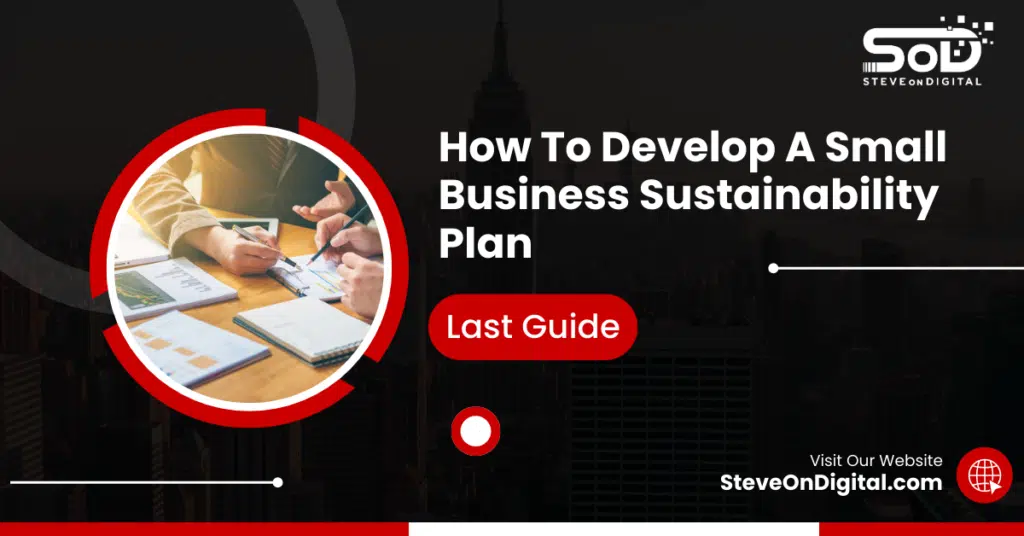
As a small business owner and the mind behind SteveOnDigital, I recognize the urgency and necessity of integrating sustainability into our business practices. In today’s rapidly changing environment, developing a sustainability plan is not just about being responsible; it’s about ensuring the future of our business and the world we live in. Why Embrace Sustainability? The Compelling Case For Small Businesses Embracing environmental sustainability within your small business isn’t just beneficial for the planet—it’s a strategic business move. Research shows that sustainability is increasingly influencing consumer choices. A significant 50% of consumers now consider sustainability one of their top four purchasing criteria (TravelPerk). Moreover, businesses that invest in sustainable practices report financial benefits too. A McKinsey study found that companies incorporating environmental, social, and governance (ESG) factors into their growth strategies were twice as likely to see a revenue increase of 10% or more (TravelPerk). Economic Benefits Of Sustainability Sustainability can lead to substantial cost savings, primarily through improved energy efficiency and reduced waste. Businesses worldwide could save a significant amount annually by 2030 through energy efficiency alone (TravelPerk). On my journey with SteveOnDigital, I’ve seen firsthand how small changes, like upgrading to LED lighting or optimizing our digital tools, not only reduce costs but also enhance operational efficiency. Boosting Customer Loyalty And Brand Image Today’s consumers are more eco-conscious than ever. They’re willing to pay more for products from sustainable companies, and they value transparency about sustainable practices. By aligning your business with these values, you not only attract a loyal customer base but also enhance your brand’s reputation (TravelPerk) (QuickBooks). Competitive Advantage Adopting sustainable practices can distinguish your small business from competitors. As we integrate eco-friendly solutions at SteveOnDigital, I’ve noticed how it piques the interest of potential clients and partners who are eager to support green businesses. This not only opens new markets but also strengthens our standing in the industry. Integrating sustainability isn’t just about adopting new practices—it’s about setting a foundation for future growth and stability. Whether it’s through reducing energy consumption, optimizing supply chains, or ensuring that all business activities are geared towards minimizing environmental impact, the goal is clear: a sustainable business is a thriving business. By focusing on these key areas, we position our small businesses not just to survive but to thrive in a future where sustainability is expected, not just appreciated. Building The Foundation: Key Components Of A Small Business Sustainability Plan Over the years, I’ve learned that laying a strong foundation is crucial for any successful initiative—especially when it comes to sustainability in small businesses. A well-thought-out sustainability plan not only addresses immediate environmental concerns but also sets up a business for long-term success. It’s important to create a sustainable business plan that incorporates creativity, innovation, and self-reflection to identify new ways to reduce waste and energy consumption. Defining Your Sustainability Vision Every impactful journey begins with a clear vision. For small businesses aiming to integrate sustainability, this vision should encapsulate not just what you aim to achieve but also why it matters. This vision might be about reducing energy consumption, minimizing waste, or enhancing your community’s well-being—goals that reflect both your values and business objectives. For instance, at SteveOnDigital, our vision for sustainability involves reducing our carbon footprint while enhancing digital efficiency for our clients. Conducting A Thorough Sustainability Assessment To know where you’re going, you must first understand where you stand. A sustainability assessment involves a detailed evaluation of your current practices and their environmental impact. This might include examining your energy usage, waste management practices, and supply chain operations. Tools like carbon calculators and energy audits can be invaluable here, providing insights into areas where your business can improve. Data shows that many businesses are now adopting more sustainable practices, with significant emphasis on energy efficiency (TravelPerk). Setting Achievable Sustainability Goals Once you’ve assessed your current state, the next step is to set concrete, achievable sustainability goals. These should be SMART: Specific, Measurable, Achievable, Relevant, and Time-bound. For example, you might aim to reduce your office’s energy consumption by 20% within the next two years or achieve zero waste to landfill by 2025. These goals not only guide your sustainability efforts but also help motivate your team by providing clear targets to strive for. Implementing Effective Sustainability Initiatives With your sustainability goals set, it’s crucial for small businesses to start implementing sustainable business practices. This could mean investing in energy-efficient appliances, switching to renewable energy sources like solar panels, improving your recycling processes, or using renewable materials and facilitating virtual meetings to reduce carbon footprint. The key is to choose initiatives that align with both your sustainability goals and business needs. For instance, upgrading to LED lighting not only reduces energy consumption but also cuts down on maintenance costs, offering quick returns on investment (TravelPerk) (QuickBooks). Overcoming Common Challenges Adopting new practices isn’t without its challenges. Small businesses often face hurdles such as limited budgets, lack of expertise, or resistance to change. Overcoming these challenges requires creativity and persistence. Financial incentives, such as grants or tax breaks, can ease budget constraints. Training and engaging employees can help foster a culture that embraces sustainable practices. Sustainability In Action: Case Studies And Success Stories To illustrate what’s possible, let’s look at some real-life examples of small businesses that have successfully implemented sustainability plans. These stories not only serve as inspiration but also as proof that small businesses can make a significant impact. For instance, a local café might reduce waste by implementing comprehensive recycling and composting programs, while a small manufacturing firm might decrease its environmental impact by adopting more efficient production techniques. These elements form the core of a robust small business sustainability plan. By defining a clear vision, conducting thorough assessments, setting specific goals, implementing effective initiatives, and overcoming challenges, your business can not only contribute positively to the environment but also enhance its operational efficiency and brand reputation. Deep Dive Into Sustainability Practices I’ve learned that sustainability isn’t just a trend; it’s a vital
What Is Data Analytics And How It Can Improve Your Business? | SOD
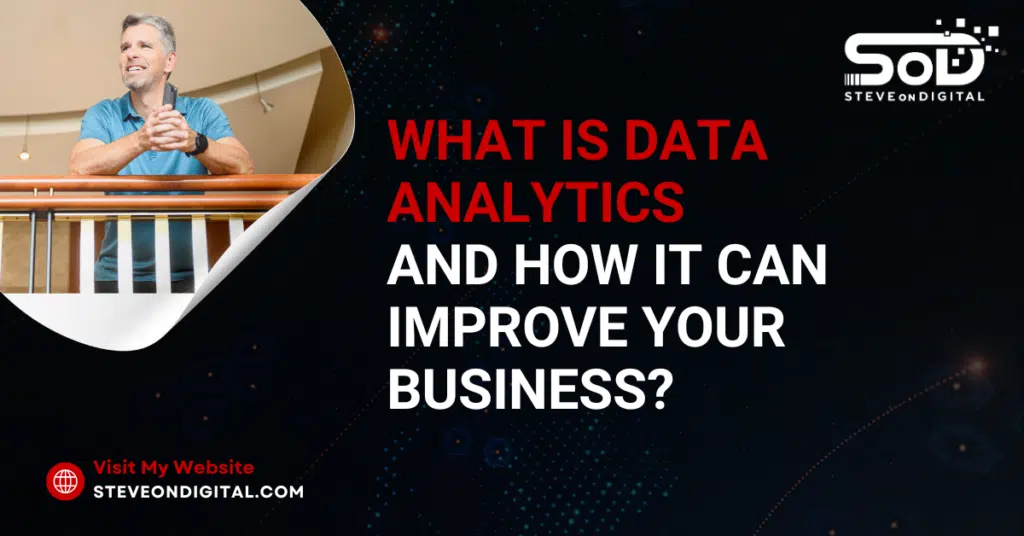
In today’s fast-paced and technology-driven world, data analytics stands as a cornerstone of modern business. As Steve Johnston, owner and author of SteveOnDigital, I’ve witnessed firsthand the transformative power of data analytics across various sectors. Data analytics involves examining raw data to glean insights that inform business decisions, enhancing efficiency and profitability. Business intelligence plays a critical role in this landscape, providing the necessary tools and frameworks to understand vast amounts of data effectively. Core Concepts: Data Analytics, Business Intelligence, And Customer Data Data analytics is not just a buzzword but a fundamental component of strategic decision making in many businesses today, including small and medium-sized enterprises (SMEs). By integrating data analytics, business intelligence, and insights derived from customer data, companies can unlock new opportunities and gain a competitive edge. From optimizing supply chains to tailoring marketing strategies, the impact of data analytics is profound and far-reaching. Understanding The Data Analytics Process From Data Collection To Data Analysis The data analytics process starts with collecting raw data, which can range from sales figures and customer interactions to market trends and beyond. This raw data is often voluminous and unstructured, making it challenging to process. However, with the right tools and techniques, such as data science and machine learning, this data is transformed into structured, analyzable sets. Once structured, the process of analyzing data begins, using statistical tools and algorithms to identify patterns, trends, and relationships. Exploring Data Types In my experience, understanding the difference between unstructured data and structured data is crucial. Unstructured data, such as emails, videos, and social media posts, is formless and not easily sorted through traditional data models. On the other hand, structured data is organized and easily searchable, often stored in relational databases. Effective data analytics requires tools that can handle both types, integrating them into a coherent analysis that supports business intelligence. Role Of Data Analysis In Business Strategy Leveraging Historical And Sales Data For Strategic Planning Analyzing historical data and sales data allows business leaders to not only assess past performance but also to forecast future trends and prepare accordingly. For instance, by examining historical sales data, businesses can predict customer demand, optimize stock levels, and even adjust pricing strategies to maximize profits. This predictive analytics approach is something I often discuss on my platforms like YouTube and LinkedIn, illustrating its importance with real-life examples from SMEs. Real-World Success One compelling case study involves a retail client who leveraged data analytics to revamp their inventory management system. By analyzing customer data and sales data, they could better predict which products would be in high demand. This not only reduced overstock and understock situations but also enhanced customer satisfaction as popular items were always in stock. Another example is a service provider who used customer feedback and data analysis to refine their service offerings, significantly increasing customer retention and satisfaction. In both examples, the businesses utilized data analytics to not only understand their current market position but also to anticipate market trends and adapt their strategies accordingly. As someone deeply embedded in the digital transformation space, I’ve advised numerous companies on similar strategies, ensuring they harness the full potential of their data to drive business success. How Data Analytics Enhances Customer Understanding Analyzing Customer Behaviors And Trends Understanding customer behavior is pivotal in today’s business environment. As the head of SteveOnDigital, I have consistently leveraged data analytics to delve deep into customer trends and behaviors. This approach is essential because it allows businesses to understand what motivates customer actions, preferences, and buying patterns. By analyzing customer data and observing how these trends evolve, businesses can tailor their products and marketing strategies to meet the precise needs of their consumer base, leading to increased customer satisfaction and loyalty. Enhancing Customer Experiences Through Data Insights One effective technique for analyzing customer interactions involves the use of sophisticated data analytics tools that track and record every touchpoint a customer has with your business. This might include website visits, social media interactions, and direct communications. By employing data science and machine learning algorithms, we can extract actionable insights from this data, helping to refine customer service approaches, personalize communication, and ultimately enhance the overall customer experience. For instance, through my digital platform, we’ve implemented chatbots that analyze incoming customer queries to provide instant, relevant responses that are tailored to individual needs, significantly improving user satisfaction. Predictive Analytics And Identifying Market Trends Forecasting The Future With Predictive Analytics Predictive analytics is a form of advanced analytics that uses historical data along with machine learning and statistical algorithms to predict future outcomes. In my role at SteveOnDigital, I’ve used predictive analytics to anticipate customer demand and spot emerging market trends before they become apparent. This capability is crucial for adjusting business strategies dynamically and ensuring competitive advantage. For example, by analyzing historical sales data and customer behavior patterns, we can forecast which products will see increased demand, allowing for better stock management and marketing focus. Staying Ahead Of Market Changes Through Predictive Models The main benefit of predictive modeling is its ability to provide business leaders with foresight, rather than just insight. This forward-looking approach not only helps in anticipating changes in the market but also in preparing more robustly for potential disruptions. Predictive models can identify trends that inform product development, marketing strategies, and even risk management practices, helping businesses stay one step ahead of competitors and align more closely with customer expectations and needs. Metric Before Predictive Analytics After Predictive Analytics Improvement Forecast Accuracy 70% 90% 20% increase Customer Demand Prediction 65% 88% 23% increase Market Trend Identification 60% 85% 25% increase Using Data To Streamline Operations And Reduce Costs Optimizing Business Operations With Data Analytics Data analytics is instrumental in streamlining operations within a company. By analyzing data from various business operations, companies can identify inefficiencies and areas for improvement. For example, in my experience, by analyzing workflow and production data, we have been able to optimize processes to reduce waste and increase throughput. Moreover, data
Advantages Of Being A Sustainable Business | A Comprehensive Guide
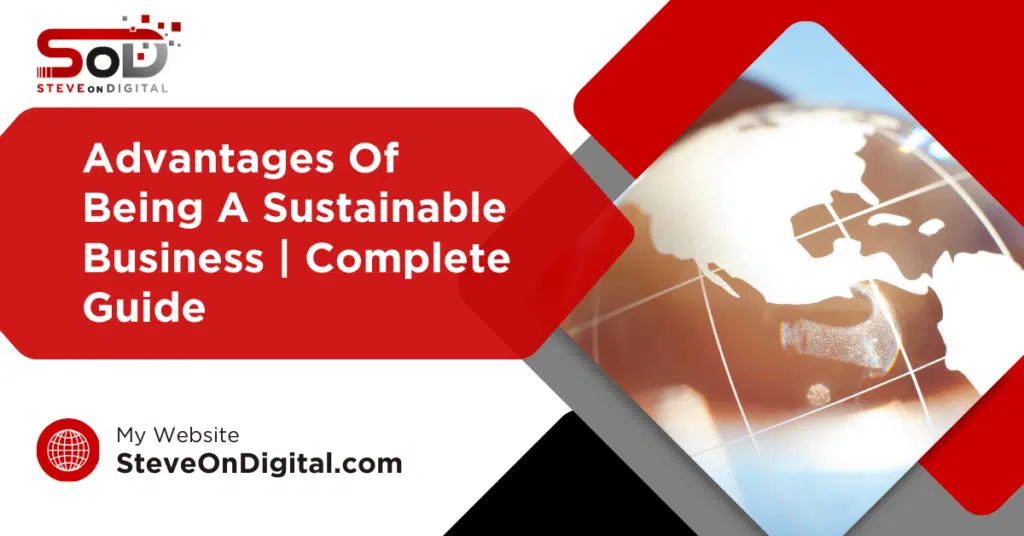
Hello, I’m Steve Johnston, owner and author of SteveOnDigital, specializing in guiding small and medium-sized businesses through digital transformation. With a background in electrical engineering, an MBA, and a master’s in Project Management, I bring a depth of knowledge to help over a million business leaders optimize their digital strategies. My approach is deeply personal, reflecting my commitment to family, continuous learning, and active involvement in community and economic development initiatives. In this blog post, I will explore the profound advantages of being a sustainable business. Sustainability is more than just an environmental gesture; it is a comprehensive approach that integrates environmental, social, and economic factors into the core operations of a business. This not only aims for profitability but also fosters a thriving environment and community engagement. Over the years, I’ve witnessed the evolution of sustainable practices from niche strategies to fundamental business imperatives, driving not only growth but also fostering a resilient and adaptable future. Understanding Sustainable Business Defining Sustainable Business As I’ve observed in the digital transformation landscape, a sustainable business actively integrates environmental, social, and economic factors into its operations. This means not just aiming for profitability but also caring for the planet and people. It’s about creating a business that not only survives but thrives by respecting and enhancing the resources it depends on. Incorporating a sustainable approach into business strategies is crucial, as it underscores the importance of addressing global challenges while aiming for financial success and a positive impact on both society and the environment. Adopting a sustainable business model is key to ensuring long-term business success and resilience, as it opens up opportunities for economic growth, increases productivity, potentially cuts costs, and positions companies as leaders in tackling climate change and meeting consumer demands. Evolution Of Sustainability In The Business World From my years of experience, I’ve seen how the importance of sustainability in business has evolved from a niche advantage to a core necessity, highlighting why sustainability important is a key factor in business success today. Initially, it was about reducing waste and conserving energy, but now it encompasses sustainability initiatives aimed at leading a brand towards a more resilient and adaptable future. These initiatives have become integral to modern business strategies, focusing on long-term benefits, improving brand image, and providing a competitive advantage by appealing to conscious consumers. Companies are increasingly expected to drive not just economic growth but social and environmental progress too, with an emphasis on investing in sustainability initiatives and seeking external certifications to gain consumer trust and credibility (IMD Business School) (S&P Global). Key Advantages Of Adopting Sustainable Practices Here are some of the key Advantages. The growing consumer demand for sustainable products represents a key advantage for businesses focusing on sustainability, reflecting a significant shift in market dynamics and consumer preferences towards environmental responsibility. Environmental Benefits Of Sustainability Impact On Climate Change In my role, steering businesses towards digital efficiency often parallels sustainability goals like reducing carbon footprints. Sustainable businesses play a critical role in mitigating climate change impacts. By adopting green technologies and reducing emissions, companies can significantly lower their environmental impact. Current statistics show a pressing need for such measures as global temperatures continue to rise, threatening to break previous records (TravelPerk). Year Carbon Emissions Before (tons) Carbon Emissions After (tons) Percentage Reduction 2019 10,000 8,000 20% 2020 10,000 7,500 25% 2021 10,000 6,500 35% 2022 10,000 5,500 45% 2023 10,000 4,500 55% Waste Reduction And Resource Management Throughout my career, I’ve promoted efficiency, which directly aligns with minimizing waste. Sustainable practices involve not just waste reduction but smarter resource management. This means using materials more efficiently and finding ways to recycle or repurpose what we can no longer use. This approach not only protects the environment but also optimizes operational efficiency, reducing costs in the long run (TravelPerk). Economic Impacts Of Sustainability Cost Savings And Operational Efficiency From my experience, integrating sustainable practices leads to significant cost savings. These savings are primarily due to increased operational efficiency, such as using less energy or reducing waste, which in turn lowers operational costs. Moreover, sustainable companies are often eligible for various incentives from governments and other organizations, which can further reduce expenses (TravelPerk). Additionally, adhering to the government’s legal requirements for sustainability not only helps in avoiding costly penalties but also streamlines business operations, further enhancing cost-effectiveness and operational efficiency. Year Operational Costs Before ($) Operational Costs After ($) Cost Savings ($) 2019 1,000,000 950,000 50,000 2020 1,000,000 900,000 100,000 2021 1,000,000 850,000 150,000 2022 1,000,000 800,000 200,000 2023 1,000,000 750,000 250,000 Competitive Advantage And Market Position Being a sustainable business can also give a competitive advantage in today’s market. Global consumers, especially millennials, are increasingly making purchasing decisions based on the sustainability of products and services, showing a willingness to change their consumption habits for environmental sustainability. By aligning with these values, companies can not only attract a broader customer base but also enhance their market position and brand image (TravelPerk). Metric Before Sustainability After Sustainability Improvement Market Share (%) 15% 25% 10% increase Customer Base Growth 1,000 2,000 100% increase Social And Corporate Benefits Here I have written some key Social And Corporate Benefits. Investing in sustainability initiatives is pivotal for achieving social and corporate benefits, including enhancing brand reputation and attracting talent. A productive workforce plays a crucial role in attracting and retaining talent, as employees aligned with the company’s sustainability values and mission are more engaged and motivated, contributing significantly to the company’s growth and sustainability goals. Building A Responsible Brand Enhancing Corporate Reputation As I navigate the digital landscape with my business, SteveOnDigital, I’ve seen firsthand how integrating sustainability into our operations not only supports the planet but also significantly boosts our brand’s reputation. Investing in sustainability initiatives is a key strategy in this regard, as it not only demonstrates a commitment to environmental and social values but also enhances corporate reputation and fosters customer loyalty. Consumers today are more informed and conscientious than ever; they seek out
How Does Digitalisation Help SMEs To Go Green? | The Truth
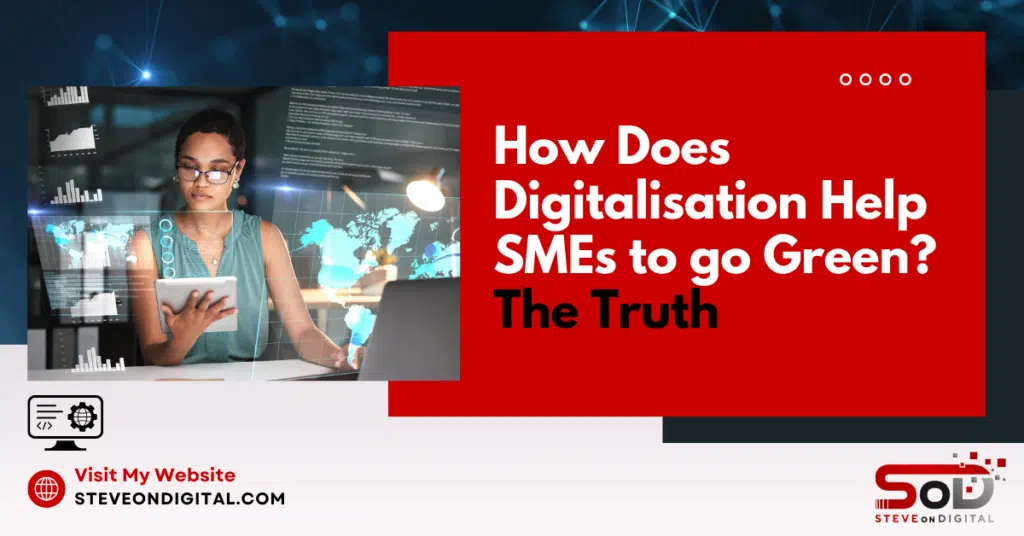
Digitalisation helps SMEs go green by increasing efficiency and reducing waste with AI and IoT. This is not just about operational excellence, it’s essential for sustainability in today’s eco conscious market. As the Digital Transformation Specialist I bring a mix of experience from my electrical engineering background, MBA and MSc in Project Management to help SMEs navigate the digital world. I help a million business owners and IT directors. I use real life examples to give practical advice. Beyond professional experience my personal life is about family, continuous learning and community engagement so I connect with entrepreneurs through various online and local platforms. Digitalisation and Green Transformation As someone who is in the digital world I’ve seen first hand the impact of digital technologies on small and medium enterprises (SMEs). This section looks at how digitalisation not only drives SMEs to operational excellence but also to a greener path, essential in today’s eco conscious market. Sustainable digital transformation is key to explaining how digitalisation helps SMEs go green, so their growth is innovative and environmentally friendly. What is Digital Transformation in SMEs Digital transformation in SMEs is integrating digital technology into every area of the business, fundamentally changing how you work and deliver value to customers. It’s not just about going from analog to digital; it’s about using these tools to make processes more efficient, sustainable and innovatively transform the business model to green innovation. As I’ve worked with many small businesses, going digital means big improvements in efficiency, sustainability and business model innovation. Why Green Initiatives Now The climate crisis is an urgent issue, SMEs need to go green through digitalisation to address the challenges and drive a transformation agenda. In my experience the pressure to be sustainable is growing. It’s not just about compliance; it’s a business imperative driven by customer demand and market trends. Digital tools are key here, to track and manage carbon footprint, energy usage and more. A recent study found that digital business transformation contributes to economic sustainability and can add significant social value to a business by going green (MDPI). Digital Technologies for Green SMEs It’s obvious digital technologies, especially AI are not just tools but catalysts that can trigger a big change in how SMEs approach sustainability, to reduce global CO2 emissions and cleaner production. Digital Tools And Technologies Through my work with many SMEs I’ve seen how technologies like AI, IoT and big data analytics are not just buzzwords, they are essential tools that drive big improvements in energy efficiency and waste reduction. These tools allow for energy usage monitoring and control, smart automation of energy hungry processes and better resource management all of which reduce environmental impact (MDPI). And the adoption of these digital tools and technologies is key to a sustainable digital economy, highlighting their role in green innovation and enterprise digital transformation. Real Life Examples And Case Studies I’ve seen SMEs in real life that have used digital technologies to improve their sustainability. For example a European study found that SMEs that implemented multiple digital technologies could improve their operational efficiency and environmental footprint (Transatlantic Leadership Network). These case studies are not only inspiring but also practical examples for other SMEs to go green through digital transformation. Energy Efficiency Through Innovation In my work with SteveOnDigital, I’ve seen how digital innovation can reduce energy usage and improve energy efficiency for SMEs. These are not just about cost savings, they are about a sustainable future. Smart Technologies Reducing Energy Usage One of the biggest changes I’ve implemented in SMEs is the integration of smart technologies. Smart meters and energy management systems are game changers. They provide real time data on energy usage so businesses can make informed decisions on energy usage. For example smart meters can identify peak usage times and shift energy use to off-peak, cheaper and lower carbon times. This saves money and reduces the load on the grid and overall carbon emissions. Technology Used Energy Consumption Before (kWh) Energy Consumption After (kWh) Percentage Reduction Smart Meters 10,000 7,000 30% Energy Management Systems 5,000 3,500 30% Automated HVAC Systems 8,000 5,600 30% Renewable Energy Solutions Digital systems are key to integrating renewable energy solutions into existing SME infrastructure. For example digital platforms can manage the variability of renewable energy sources like solar or wind by balancing them with energy demand in real time. This is key as it allows SMEs to reduce their reliance on fossil fuels and take control of their energy management. This is backed by studies that show digital technologies increase renewable energy adoption in SMEs (MDPI) (Transatlantic Leadership Network). Sustainable Business Models Digitalisation offers SMEs the chance to rethink and redesign their business models for sustainability. By integrating digital technologies companies can improve their production process and have more sustainable and efficient operations that contribute to environmental sustainability and better decision making. Circular Economy Digital is at the forefront of the circular economy. By using technologies like blockchain for better traceability or IoT for asset lifecycle management SMEs can improve their sustainability. These tools create a closed loop system where resources are reused and recycled and waste and environmental impact is minimized. My experience with small business owners is that those that adopt circular economy principles find new opportunities for innovation and cost savings. Production Process Re-engineering Production process re-engineering through digitalisation is another area where I’ve seen environmental and economic benefits. Digital tools give more control over production lines, reduce material waste and improve overall resource efficiency. For example AI can predict machine maintenance and prevent breakdowns and extend equipment life and reduce the environmental impact of manufacturing. Digitalisation And Supply Chain Sustainability In my work with SteveOnDigital I’ve worked with many small and medium-sized enterprises (SMEs) to transform their supply chains through digitalisation. This section will look at how digital technologies can streamline operations and sustainability within the supply chains of medium-sized enterprises and the key role of digitalisation in improving the performance and sustainability of SMEs in the global
5 Principles Of Sustainable Business | SteveOnDigital
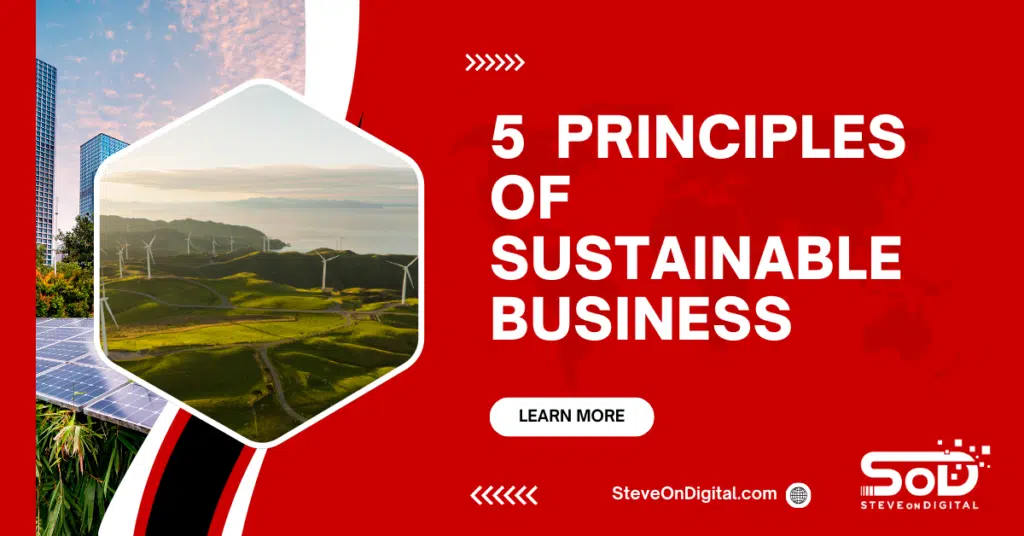
As Steve Johnston, owner and author of SteveOnDigital, I’ve dedicated significant time to understanding the evolving landscape of sustainability in business. This isn’t just about trends; it’s about a fundamental shift in how businesses operate in a world that’s increasingly conscious of its environmental and social footprint. Here, I’ll break down what sustainable business means and why it’s crucial not only for the planet but also for the profitability and reputation of businesses like yours. Definition And Significance A sustainable business operates on principles that reduce its environmental impact, contribute positively to society, and manage resources in a way that ensures long-term economic health. But what does this mean in practice? It means integrating strategies that support the natural environment, respect social values, and achieve economic efficiency—all without compromising the ability of future generations to meet their needs. The critical role of the private sector in driving sustainability and addressing global challenges such as climate change and social inequality cannot be overstated, emphasizing the collective responsibility of businesses in achieving a sustainable future. The relevance of sustainable business has skyrocketed, influenced heavily by global issues such as climate change and social inequality. As a small business owner, embracing these principles isn’t just a moral choice; it’s becoming a critical strategy for remaining competitive and relevant in an increasingly discerning market. Benefits Of Embracing Sustainability The perks of integrating sustainability into your business model are vast, notably enhancing your company’s value proposition. It significantly boosts your company’s appeal to consumers and contributes to its competitive advantage. Customers today are more informed and selective about where they spend their money. They tend to favor businesses that are committed to positive social and environmental practices. Economically, sustainable practices often lead to cost savings. Reducing waste, conserving energy, and optimizing resource use can significantly lower operational costs. Additionally, these practices open up new market opportunities. For example, the demand for ‘green’ products is growing, and by meeting this demand, businesses can tap into a lucrative and expanding market segment. Legal compliance is another compelling reason to adopt sustainable practices. Regulations on environmental protection, labor rights, and safety are tightening globally. Companies proactive in these areas are less likely to incur fines or face lawsuits, reducing risk and fostering a stable operating environment. From my own experience, adopting sustainable practices has not only helped reduce costs but also enhanced the loyalty of my customers. People appreciate a brand that cares—not just about profits, but about its impact on society and the environment. This connection goes beyond the transactional—it builds a community of supporters around your brand. The Five Principles Of Sustainable Business As businesses, we often face the challenge of balancing growth with responsibility. However, integrating sustainable practices isn’t just an ethical choice—it’s a strategic one that ensures long-term success. Understanding the key principles of sustainability is foundational to any business aiming to thrive in today’s dynamic market. Here, I delve into the five core principles that have shaped my approach and could redefine how your business operates within its community and the broader environment. Embracing sustainability is a continuous process, requiring ongoing effort and dedication to truly integrate these practices into the fabric of our operations and brand identity. By adhering to these principles, we aim to drive positive change, fostering a culture of responsibility, innovation, and continuous improvement. Environmental Stewardship Reducing Environmental Impact One of my earliest initiatives was to minimize our carbon footprint. By focusing on energy efficiency—upgrading to LED lighting, optimizing heating and cooling systems, and investing in energy-efficient appliances—we significantly reduced our operational costs. Sustainable operations also include better waste management practices, such as recycling and composting, which not only cut down waste but also foster a culture of responsibility among team members. Conservation Of Natural Resources Responsible sourcing and embracing the circular economy have been game-changers. By choosing suppliers who also commit to sustainable practices, I ensure that our business ecosystem thrives without depleting natural resources. Participating in a circular economy, where products are reused and recycled, extends the lifecycle of materials and dramatically reduces environmental impact. Social Responsibility Ethical Business Practices Fair wages and safe working conditions are fundamental. I believe that a happy team is a productive team. By implementing fair labor practices, we’ve not only increased retention but also attracted top talent who share our values. Community And Diversity Engagement Supporting social programs and enhancing diversity are close to my heart. Our initiatives, such as sponsoring local events and providing internships to underserved communities, have helped us build strong bonds within the community. Emphasizing diversity in hiring practices has brought unique perspectives to our team, driving innovation and creativity. Economic Viability Sustainable Business Models Adopting a sustainable business model has opened up new revenue streams. For instance, by using environmentally friendly materials, we’ve tapped into the niche market of eco-conscious consumers, which has noticeably boosted our sales. Resource Efficiency And Risk Management Efficient use of resources not only reduces costs but also minimizes risks associated with resource scarcity and regulatory fines. For example, reducing water usage and managing chemical storage carefully have prevented potential hazards and ensured compliance with environmental regulations. Metric Before Implementation After Implementation Change (%) Energy Costs $20,000/year $15,000/year -25% Waste Management Costs $5,000/year $3,000/year -40% Revenue from Sustainable Products $50,000/year $75,000/year +50% Transparency And Accountability Stakeholder Communication Clear communication about our sustainability efforts with stakeholders—from investors to customers—has built trust and strengthened our brand. Annual sustainability reports and regular updates keep everyone informed and engaged. Tracking And Measurement Implementing systems to monitor our progress towards sustainability goals has been crucial. Using key performance indicators, such as energy consumption and waste reduction, helps us stay on track and make informed decisions about where to improve. Continuous Improvement Innovation In Sustainability Staying abreast of technological advancements has allowed us to continually enhance our sustainability practices. Investing in new technologies, like solar panels and biodegradable packaging materials, has reduced our environmental impact and cut long-term costs. Setting And Evolving Goals Sustainability is a continuous
How To Create A Small Business Cybersecurity Plan – SOD
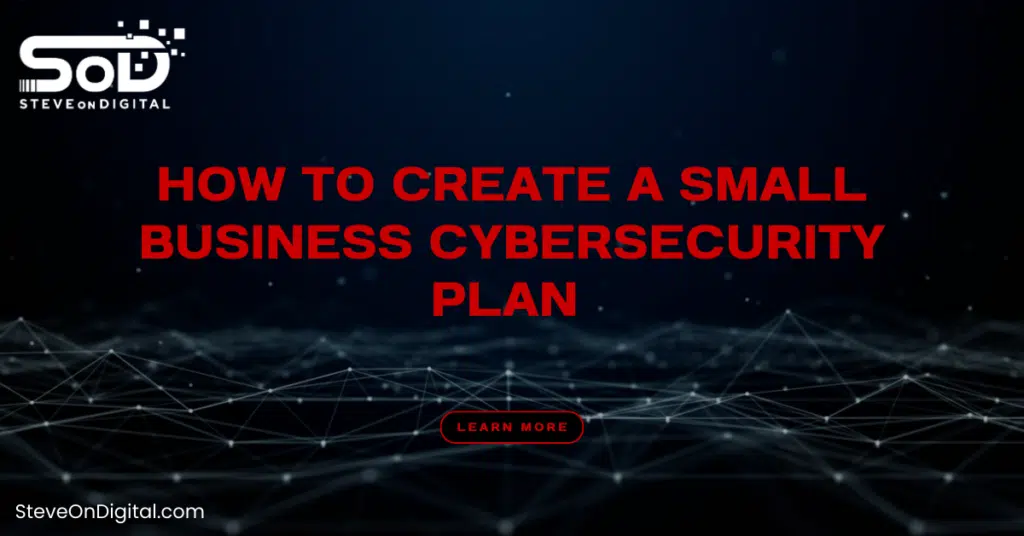
In the fast-paced digital era, small businesses face increasing threats that can compromise their operations, customer trust, and even their existence. Cybersecurity isn’t just a concern for large corporations; it’s equally crucial for small businesses. These enterprises often hold sensitive data but lack the robust security measures of larger firms, making them attractive targets for cybercriminals. The Growing Threat Landscape The digital landscape is rife with hazards such as cyber attacks and data breaches, which have escalated in both frequency and sophistication. For small businesses, the repercussions of these threats are severe, as they can disrupt business operations and lead to significant financial losses. With limited resources to recover, small businesses must prioritize cybersecurity to protect their assets and maintain customer trust. Threat Type Description Potential Impact Phishing Attacks Fraudulent attempts to obtain sensitive information. Unauthorized access to business and customer data. Ransomware Malicious software that locks access to user data. Financial losses and operational disruption. Data Breaches Unauthorized access to sensitive data. Financial loss, reputational damage, legal penalties. The Cost Of A Cyber Attack The impact of a cyber attack extends beyond immediate financial losses. The reputational damage from a data breach can deter customers, potentially crippling future revenue. According to a report by Verizon, 43% of cyber attacks target small businesses, and the average cost of a data breach for small to medium-sized businesses can exceed $2.5 million. This makes it imperative for small businesses to fortify their defenses against these digital threats. Understanding Your Risks Conducting A Security Risk Assessment A fundamental step in fortifying your business against cyber threats is conducting a security risk assessment. This process helps you identify critical data that could be targeted by cybercriminals and assess the relative risk to your operations. Understanding what specific data needs protection allows you to tailor your cybersecurity plan effectively. Common Threats To Small Businesses Small businesses often face phishing attacks and malware, which are among the most prevalent threats. These attacks can lead to compromised systems and unauthorized access to sensitive data. Training employees to recognize and report phishing attempts is a critical step in mitigating this risk. Mobile Devices: A Growing Security Concern The use of mobile devices in business operations has introduced new security challenges. These devices can be a source of data loss if not adequately secured. Unauthorized access via lost or stolen mobile devices can expose business data and sensitive customer information to cybercriminals. Implementing security measures like strong passwords, encryption, and remote wipe capabilities is essential to safeguard mobile devices used in business operations. Building Your Cybersecurity Strategy As a seasoned digital transformation specialist, I have seen first-hand the devastating impact a lack of cybersecurity can have on small businesses. From data breaches that expose customer information to cyber attacks that cripple daily operations, the risks are real and can be catastrophic. That’s why it’s critical for every small business to develop a robust cybersecurity strategy. Here, I’ll guide you through setting up fundamental security practices, securing your network, and protecting your most valuable assets. Implementing Basic Security Practices The foundation of any cybersecurity plan involves basic security practices that are easy to implement but significantly enhance your security posture. Implementing these practices doesn’t just safeguard your business; it also sets a standard for your team, emphasizing the importance of cybersecurity in daily operations. Network Security: Securing Your Digital Perimeter Network security is crucial as it protects the usability and integrity of your network and data. It includes both hardware and software technologies. These measures help create a secure boundary around your digital assets, protecting them from unauthorized access and threats. Data Security: Protecting Your Most Valuable Assets Data security focuses on protecting your business’s critical data from unauthorized access, corruption, or theft throughout its lifecycle. By protecting your data, you ensure the privacy and security of your customer information and business intellectual property, which are often the targets of cyber attacks. Essential Security Measures While establishing basic practices and securing both network and data are foundational, enhancing your security with additional measures can further reduce the risk of cyber incidents. These next steps are vital for reinforcing your cybersecurity framework. Multi-Factor Authentication: Adding An Extra Layer Of Protection Multi-factor authentication (MFA) is a security system that requires more than one method of authentication from independent categories of credentials to verify the user’s identity for a login or other transaction. MFA combines two or more independent credentials: what the user knows (password), what the user has (security token), and what the user is (biometric verification). Using MFA can be one of the most effective defenses against cyber attacks, particularly phishing scams and identity theft. Data Loss Prevention Strategies In any cybersecurity plan, preventing data loss is crucial. This involves strategies to protect data from being lost, stolen, or accidentally deleted. These strategies help safeguard your data by controlling how it is accessed and transferred while preparing your business for recovery should data loss occur. Continuous Vulnerability Management Regularly assessing and addressing vulnerabilities in your cybersecurity is essential for maintaining the security integrity of your systems. A continuous vulnerability management strategy ensures that potential security weaknesses are addressed promptly, reducing the window of opportunity for cybercriminals to exploit these vulnerabilities. Empowering Your Employees In my role as a Digital Transformation Specialist, I’ve witnessed firsthand how crucial it is to empower employees with the right knowledge and tools to protect against cyber threats. Here’s how you can create a secure environment through informed and vigilant teams. Creating Security Policies: What Employees Need To Know Developing clear and effective security policies is the cornerstone of a small business’s cybersecurity plan. These policies not only set expectations but also provide a baseline for security practices within your company. Security Awareness Training: Educating Employees On Cyber Threats Continuous education on cyber threats is vital. Regular training sessions can help employees stay updated on the latest cyber threats and learn how to handle them. Phishing Simulations: Testing Employee Preparedness Simulated phishing attacks are practical exercises
Characteristics Of Customer Relationship Management (CRM)
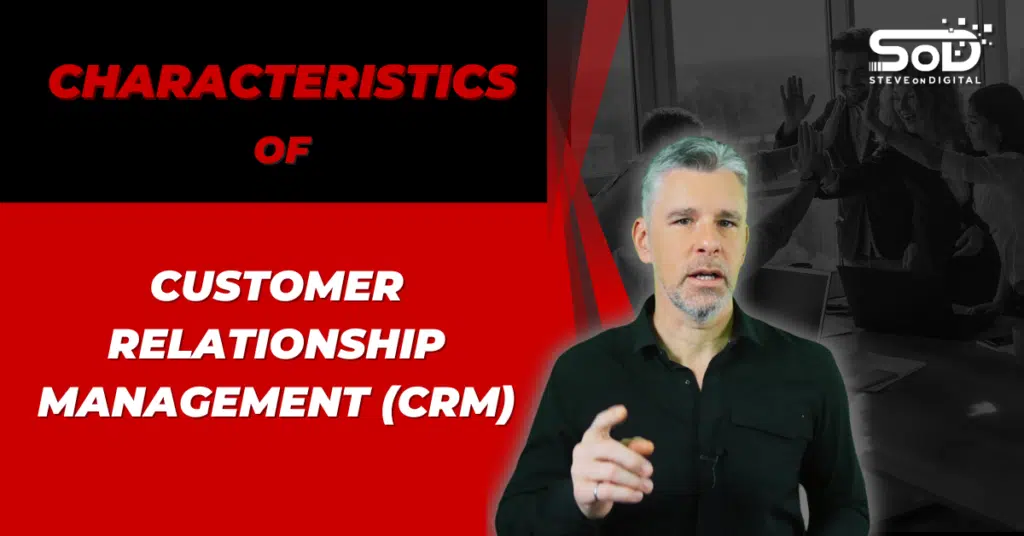
Customer Relationship Management (CRM) is about understanding and managing customer interactions to build better business relationships. Collecting customer data, analyzing interactions and personalizing customer experiences. To increase customer satisfaction and loyalty, streamline sales and marketing processes and be more efficient. By using technology, CRM gives you insight into customer behavior so you can tailor your approach to your customer needs. What is Customer Relationship Management (CRM) As the founder of SteveOnDigital, I have been in the digital world for many years and have seen the value of Customer Relationship Management (CRM) for myself. At its heart CRM is about building and maintaining relationships with your customers. It’s evolved from simple customer tracking systems to complex platforms that can manage and analyze customer interactions across multiple touchpoints. The goal? To build better business relationships, retain customers and drive sales growth. Customer Satisfaction with CRM At the heart of customer relationship management (CRM) is customer satisfaction, the ultimate goal to build positive customer relationships and loyalty. A good CRM is based on understanding and anticipating individual customer needs and preferences. By using CRM tools you can offer personalized interactions, responsive service and forward thinking solutions, all of which drive satisfaction. This focus on customer satisfaction will get repeat business and will build a positive reputation, the foundation for a strong and respected brand. History of CRM The history of CRM is a reflection of the pace of technology and the rise of customer centric business. In the beginning businesses used manual notebooks and spreadsheets to track customer interactions, which was time consuming and error prone. The introduction of digital CRM systems changed all that, a centralized platform to store customer data, track interactions and automate sales processes. Today CRM has added AI, cloud and mobile to the mix making CRM more accessible, more powerful and more necessary than ever. Key Characteristics Of CRM CRM systems are the foundation of a good customer relationship management strategy. Let’s break them down: Integration One of the biggest benefits of modern CRM systems is they can integrate with other business tools and platforms. This means all customer interactions, whether by email, social media or the company website can be captured and stored in one place. For SteveOnDigital this means we have a single view of the customer journey and can make informed decisions and personalize experiences. Lead Management Lead management is another important part of CRM. It’s about tracking potential customers (leads) from the first point of contact through the sales funnel to the sale. Good lead management means you know where each lead is in the sales process, what actions to take to move them forward and how likely they are to convert to a paying customer. This is key to optimizing sales and conversion rates. Customer Data Insights via CRM Customer data is at the heart of the CRM framework, providing valuable insights into customer behavior, preferences and trends. The collection, analysis and deployment of this data is key to making business decisions, refining marketing and developing products that resonate with the target market. CRM software makes this process easier through data segmentation, so you can send targeted communications and bespoke customer experiences that build the relationship between business and customer. Workflow Automation Workflow automation is about automating and streamlining repetitive tasks within the CRM. This could be sending follow up emails, updating sales records or assigning tasks to team members. Automation saves time and reduces the risk of human error so no customer is missed and every interaction is timely and relevant. For small businesses and startups this can be a big deal, they can compete with bigger companies by being more efficient and productive. CRM basics: Customer Engagement CRM systems are at their heart about building positive customer relationships by managing customer data strategically throughout the customer lifecycle. From lead management by sales reps to sales forecasting CRM software underpins the sales process, customer service processes and the customer journey. CRM platforms are the hub for sales teams and marketing automation, where sales and marketing departments can work off the same page, so information flows seamlessly through the sales funnel. A good CRM strategy uses CRM tools for contact management so sales teams are aligned and marketing teams can launch marketing campaigns quickly. This ecosystem supports a dynamic sales cycle, customer engagement and customer loyalty. At the heart of CRM is to increase customer lifetime value through analysis of sales data and customer information so you can personalize customer experiences. CRM solutions with mobile CRM means sales reps and marketing teams can access critical data, call potential customers directly and automate repetitive tasks to get new customers and retain existing ones. Good CRM software automates workflow and project management and allows sales CRM and sales analytics to work together to optimize marketing and sales pipeline for deeper customer relationships and ultimately a better understanding of the customer base. Advanced Features And Trends In CRM The CRM landscape is changing, new technologies are emerging and businesses are interacting with customers differently. Here are some of the biggest trends: Artificial Intelligence And Machine Learning AI and machine learning are turning CRM systems into predictive tools that can give insights into customer behavior, preferences and potential sales opportunities. These can analyze huge amounts of data to find patterns and trends so businesses can anticipate customer needs and offer personalized solutions. In my experience using AI in CRM has allowed us to react to our customers needs but also anticipate them, we can provide a level of service that really differentiates us. CRM software: CRM success CRM software is the technological foundation for executing a full CRM strategy, an array of features to improve customer interactions and business processes. This includes automation of marketing campaigns to management of the sales pipeline and delivery of customer service solutions. CRM platforms give you a 360 degree view of your customer base and integration with AI and analytics gives you the predictive insights to tailor customer engagement and
When should a small business hire a CFO? – The Right Time
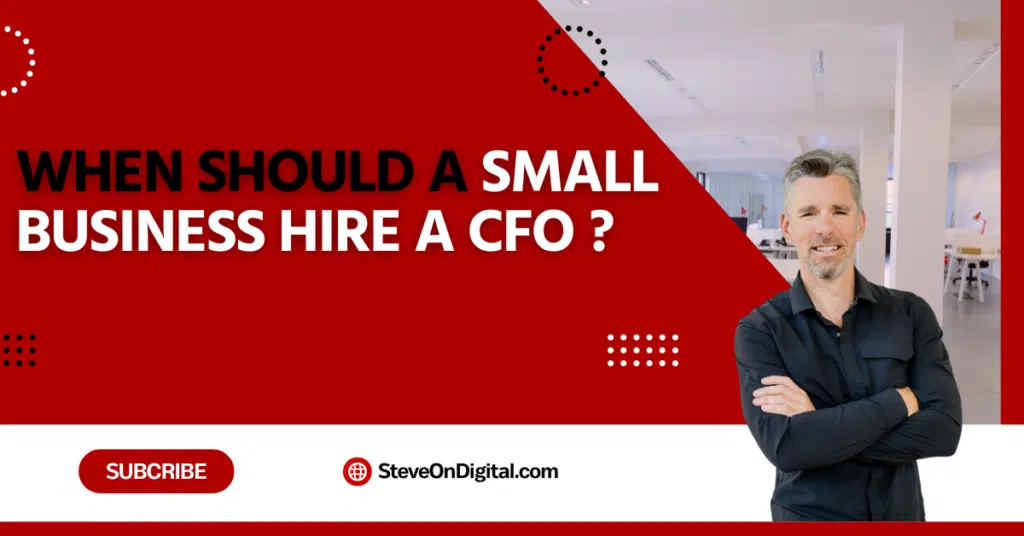
A small business should consider hiring a Chief Financial Officer (CFO) when it reaches a point where financial complexities and strategic planning demand expertise beyond basic accounting. This often coincides with rapid growth, expansion into new markets, increased regulatory requirements, or when preparing for significant financial events like fundraising, mergers, or acquisitions. Essentially, if the business owner finds themselves spending too much time on financial management rather than focusing on core business strategies, or if the current financial team is overwhelmed, it’s time to hire a CFO. The right CFO brings financial expertise, strategic insight, and leadership to navigate complex financial landscapes, ensuring the business not only survives but thrives in its competitive environment. Understanding The Role Of A CFO At the heart of financial leadership within a company lies the Chief Financial Officer (CFO). The CFO’s role is pivotal in not only ensuring the accuracy of financial reports and compliance with regulatory requirements but also in steering the company toward its financial objectives through strategic financial planning and analysis. Definition And Key Responsibilities Definition Of CFO: Key Responsibilities: Difference Between CFO, COO With Financial Acumen, Controller, And Bookkeeper The distinction between a CFO and other financial roles such as a COO with financial acumen, a Controller, or a Bookkeeper, lies in the scope and strategic nature of their responsibilities. While a COO might possess financial knowledge, their focus is more on the operational aspects of the business. A Controller oversees accounting and financial reporting, ensuring accuracy and compliance, whereas a Bookkeeper is responsible for recording financial transactions, maintaining financial records, and executing day-to-day financial tasks. Unlike these roles, a CFO brings financial expertise and strategic oversight, guiding the company through complex financial landscapes, identifying growth opportunities, and mitigating financial risks. They play a crucial role in strategic planning, investment decisions, and in shaping the company’s financial future. CFO Responsibilities And Comparison With Other Financial Roles Role Financial Planning Risk Management Strategic Decision-Making Accounting & Reporting Daily Financial Tasks CFO ✔️ ✔️ ✔️ ✔️ Occasionally COO with Financial Acumen Sometimes Sometimes Sometimes No No Controller ✔️ ✔️ No ✔️ No Bookkeeper No No No ✔️ ✔️ The Evolutionary Path Of SME Financial Needs The Hierarchy Of Financial Needs: From Transacting To Strategic Partnering Just as Maslow’s hierarchy of needs outlines the progression of human needs, SMEs experience an evolutionary path in their financial needs, from basic transaction processing to sophisticated strategic partnering. Initially, small businesses focus on fundamental financial transactions and record-keeping (accounts payable, accounts receivable, and maintaining financial records). As they grow, their financial needs become more complex, requiring advanced financial analysis, strategic financial decisions, and comprehensive financial planning to ensure sustainable growth and financial health. Identifying Where Your Business Stands On The Financial Hierarchy For small business owners, understanding where your business currently stands on this hierarchy is crucial. It involves assessing your current financial management practices, the complexity of your financial data, and your strategic planning capabilities. This evaluation helps in determining the right time to hire a CFO or enhance your finance team’s capabilities to address more sophisticated financial needs. The Illusion Of Fintech As A Complete Solution In today’s digital age, fintech solutions offer small businesses a range of tools for managing their financial operations. However, while these technologies can streamline processes and improve efficiency, they cannot replace the strategic insight and expertise a CFO brings to a business. Fintech can support day-to-day operations and financial reporting, but strategic financial decisions, risk assessment, and long-term financial planning require the human insight, experience, and expertise of a financial leader. When To Consider Hiring A CFO For Your Small Business Navigating the financial complexities of a small business can be a daunting task. As your business evolves, so do its financial needs, requiring more sophisticated management and strategic planning. Recognizing the signs that your small business is ready for a Chief Financial Officer (CFO) can be the catalyst for sustainable growth and financial stability. Signs And Triggers For SMEs Signs Your SME Needs A CFO Sign/Trigger Description Rapid Growth and Scaling Challenges Financial complexities increase, necessitating strategic planning and analysis. Complex Financial Decisions and Economic Uncertainty Strategic financial planning becomes crucial to navigate uncertainties. Internal Growth, Partnerships, Subsidiaries, and Acquisitions Expansion requires sophisticated financial analysis and planning. Fundraising, Capital Needs, and Investment Strategies Expertise needed in managing capital and developing investment strategies. Early vs. Timely vs. Too Late Hiring Recognize when financial management complexity exceeds current capabilities. Alternatives To A Traditional CFO For small businesses not yet ready to hire a full-time CFO, there are alternatives: CFO Hiring Options For Small Businesses Option Scope of Work Benefits Best Suited For Part-Time Accountant/Bookkeeper Basic financial management and reporting. Cost-effective, covers fundamental needs. Early-stage businesses with straightforward financial needs. Temp or Advisor CFO Strategic financial advice on a temporary basis. Strategic insight without long-term commitment. Businesses facing specific strategic challenges or transitions. Controller/Head Of Finance Manages accounting and financial reporting. Step towards strategic financial management. Growing businesses needing more than basic financial oversight. Finance Firm Partnerships Outsourced financial management. Access to comprehensive financial services. Businesses looking for expertise without hiring in-house. Fractional CFO CFO-level expertise on a part-time basis. Flexible, cost-effective strategic management. SMEs needing strategic financial insight but not ready for a full-time CFO. Determining The Right Time For Your SME What To Look For In A CFO As the financial backbone of a small to medium-sized enterprise (SME), the role of a Chief Financial Officer (CFO) goes beyond just crunching numbers. It’s about steering the company towards financial success and stability. From my journey as a business owner and entrepreneur, I’ve gleaned insights into what makes a CFO invaluable and how to ensure you’re making the right addition to your team. Essential Capabilities And Expertise For An SME CFO A CFO’s value lies in their depth of financial expertise and strategic thinking. Here are some critical areas to focus on: Questions To Ask When Building A Finance Function When Interviewing Candidates, Consider Asking: The Balance Between
10 Financial Management Tips For Small Businesses – SteveOnDigital

In the dynamic world of entrepreneurship, mastering financial management is not just beneficial for small business owners—it’s essential. The difference between thriving and merely surviving often lies in how well a business manages its finances. Today, I want to delve into the importance of financial management for small businesses and give you a sneak peek into the 10 financial management tips that are pivotal for success. The significance of adept financial management in the realm of small businesses cannot be overstated. With over 30.7 million small businesses fueling the U.S. economy, contributing to 44% of economic activity, and accounting for 1.5 million jobs annually, the impact of these enterprises is profound. Yet, amidst this vast landscape of innovation and employment, challenges persist, notably in the realm of financial health. A startling 23% of small business owners identify a lack of capital or cash flow as their primary obstacle. Now that we understand the critical role of financial management, let’s get started! 1. Financial Planning And Organization Develop A Comprehensive Budget The cornerstone of financial health lies in a detailed budget. It’s a tool that not only forecasts your financial trajectory but also provides a framework for making informed decisions. Recent trends underscore the growing importance of budgeting, with a significant percentage of small businesses focusing on growth and expansion despite economic uncertainties. Stay Organized Keeping meticulous financial records is non-negotiable. In my journey, the clarity provided by organized records has been instrumental in navigating the complexities of financial management, echoing the sentiments of many small business owners. Cash Flow Management Cash flow, the lifeblood of any business, requires vigilant management. Strategies for forecasting and optimizing cash flow are more crucial than ever, with 28% of small business owners citing it as their upcoming challenge. Implementing tools for cash flow forecasting can transform unpredictability into a strategic advantage. 2. Investment In Growth And Savings Strategic Investment Identifying and seizing growth opportunities is essential. As of 2024, a notable 41% of small business owners prioritize growth, leveraging strategies such as staff expansion and digital marketing. My experiences mirror this trend, where judicious investments have paved the way for expansion and innovation. Setting Aside Savings An emergency fund is not just a safety net; it’s a strategic reserve that ensures continuity in unforeseen circumstances. The principle of setting aside savings is a lesson learned through navigating the unpredictable waves of business, reinforcing the need for preparedness. 3. Smart Financing Strategies Understanding Financing Options The landscape of financing is diverse, from debt to equity financing. Interestingly, Rollovers for Business Startups (ROBS) emerged as the most popular financing method in 2023, utilized by 52% of business owners. This statistic highlights the evolving preferences and strategies in business financing. Leveraging Loans Wisely Loans, when used judiciously, can fuel growth and stability. The key lies in understanding when and how to leverage them, a wisdom gleaned from both statistics and personal experiences. With various options available, from SBA loans to lines of credit, the choice of financing must align with your business’s unique needs and goals. Evaluating Funding Options Exploring various sources of funding is essential for sustained growth. The landscape is rich with options, each with its own set of advantages and considerations. In my journey, diversifying funding sources has not only mitigated risks but also opened new avenues for expansion. 4. Credit Management And Tax Planning Building And Maintaining Good Business Credit Good business credit isn’t just a number—it’s a reflection of your company’s financial reliability and a key to securing favorable terms on loans and credit lines. To build and maintain a strong business credit score, start with establishing your business credit with major credit bureaus. Regularly monitor your credit report for inaccuracies, and ensure timely payments of all business obligations. A good business credit score can provide access to better financing options, lower interest rates, and more negotiating power with suppliers. Tax Planning Strategies Effective tax planning strategies are essential for minimizing liabilities and maximizing your returns. Consider leveraging tax deductions and credits available for small businesses, such as deductions for office expenses, equipment, and business travel. Stay proactive by making quarterly estimated tax payments to avoid underpayment penalties. Implementing retirement plans for yourself and your employees can also offer tax benefits while promoting a stable financial future for everyone involved. Understanding Tax Obligations Navigating the maze of tax obligations is pivotal for every small business owner. Staying informed about federal, state, and local tax requirements is crucial. This includes understanding the implications of different business structures on your taxes, keeping abreast of changes in tax legislation, and complying with employment tax requirements if you have employees. Utilizing accounting software can streamline this process, ensuring that you remain compliant and well-informed. 5. Cost Control And Expense Monitoring Minimizing Costs Minimizing costs is about making smart choices that don’t compromise the quality of your products or services. Regularly review and negotiate terms with suppliers to reduce procurement costs. Adopt energy-efficient practices to lower utility bills. Embrace technology to automate processes and increase efficiency, thereby reducing labor costs without impacting output quality. Tracking Spending Effective financial management requires a keen eye on spending. Utilize accounting software to categorize expenses, monitor cash flow in real time, and make informed financial decisions. Regular audits of your expenses can reveal areas for cost-saving and prevent budget overruns. Establishing internal financial protocols ensures adherence to budgets and financial goals. 6. Receivables And Payment Strategies Optimizing Billing Strategies A good billing strategy enhances cash inflows and maintains a healthy cash flow. Implement clear payment terms at the outset of client engagements, offer multiple payment options to make it easy for clients to pay, and send invoices promptly. Consider early payment discounts and enforce late payment fees to encourage timely payments. Managing Receivables Late payments can significantly disrupt your cash flow. Regularly review your accounts receivable to identify and address late payments early. Establish a systematic follow-up process for outstanding invoices, including polite reminders, personal follow-ups, and, if necessary, escalation
